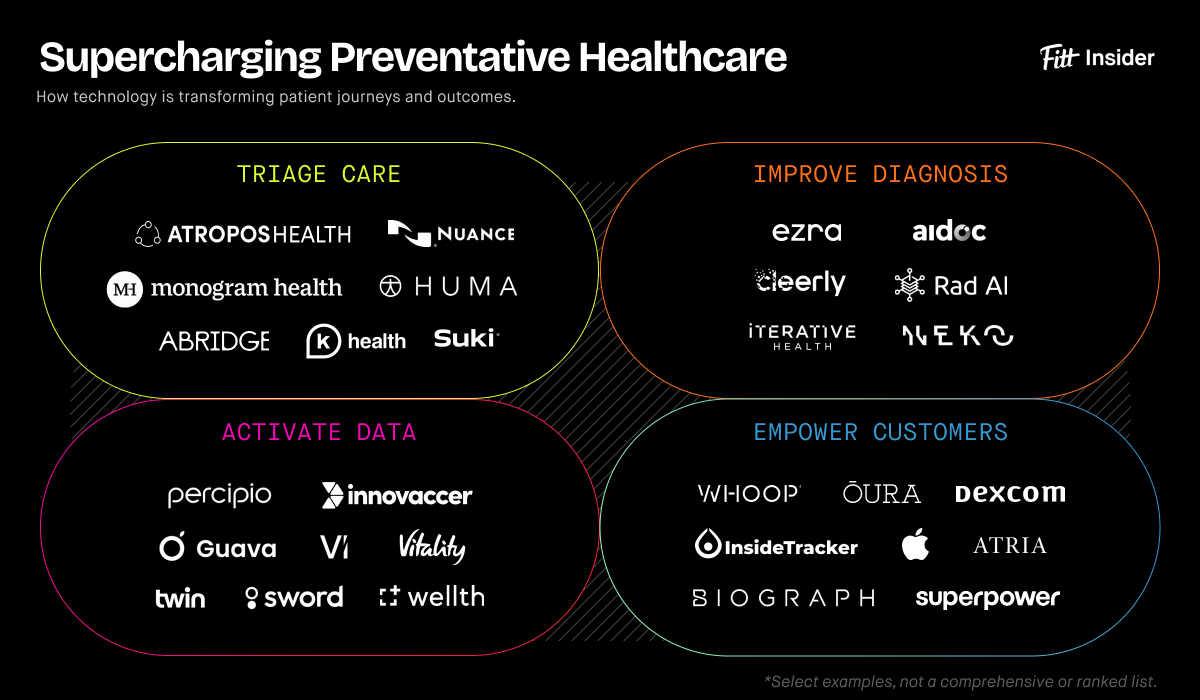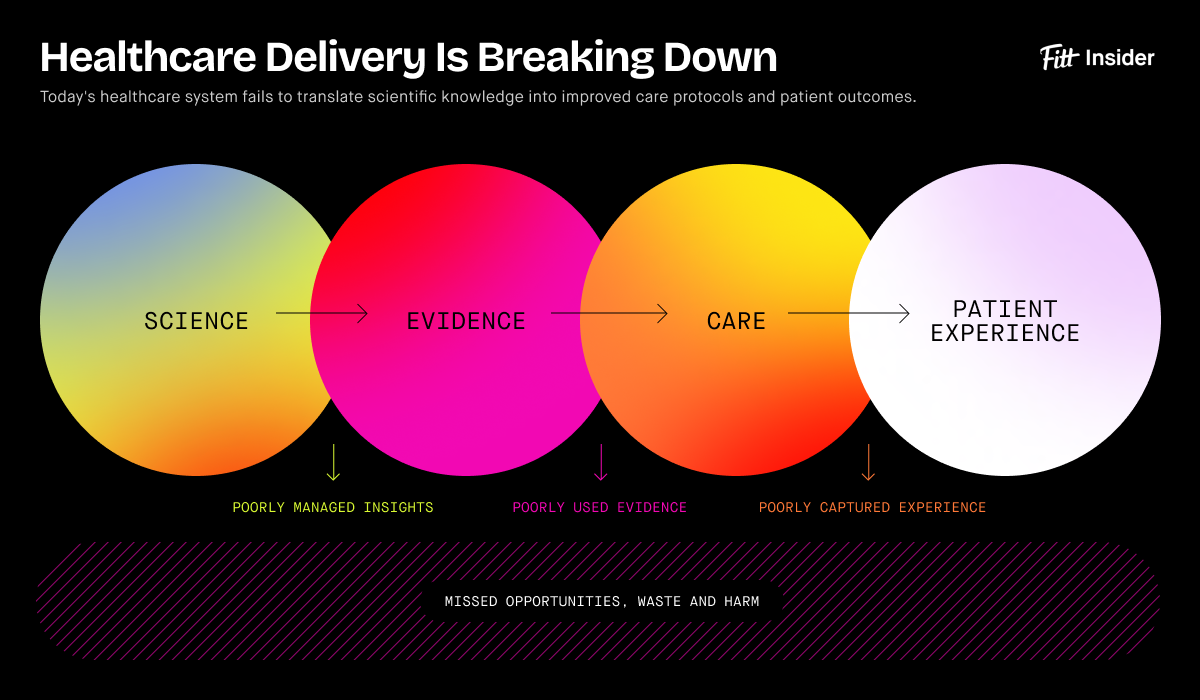Pt. II: Consumer Health Solutions
In-person visits will provide a baseline, but patients will need ongoing guidance. A continuation of care, AI can map home wellness routines to amplify adherence and agency.
In the US, 90% of healthcare spend goes toward managing chronic disease. If nothing changes, costs are expected to exceed $9T by 2028.
Lifestyle factors like inactivity, poor nutrition, and substance use cause over half of preventable deaths — pointing to problems of time, access, education, and motivation, not medication.
Unfortunately, just 37% feel empowered by the current healthcare system, while counterforces like Big Food and social media companies spend billions nudging toward bad habits.
In a culture constructed on cheap dopamine, hammering willpower without laying new scaffolding won’t work, but consumer-centric AI might help.


Mission Control Center
To prevent overwhelm, a master hub must translate data from wearables, biosensors, wellness apps, EHRs, and diagnostics into action plans.
Connecting clinical data and real-time biometrics, multimodal AI could inform an all-seeing health optimization dashboard — directly linking lifestyle habits to better outcomes. Emulating the UX of a wealth management robo-advisor, users could enter an end health goal and project likelihood of success based on current habits, adjusting behavior as needed to stay on track.
Playing aggregator, Guava Health’s dashboard is on trend. Extending its brand, Apple could also become the center — transforming its Watches, AirPods, and iPhones into ambient monitors that feed a health super app. For specialized health, wellness, and fitness point solutions, integration with this central hub will be key.
Pushing DTC tests, digital companies like Superpower and InsideTracker already analyze everything from hormones to microbiome and genetics, guiding preventative action. But, marketing to optimizers, their message is lost on more casual wellness consumers.
Palm Pilots
Companion apps can put expert protocols in people’s palms.
Forecasting disease only helps if consumers know what to do next. Adding AI capabilities, wellness companies are 10xing knowledge and support.
A holistic advisor, Oura’s AI delivers personalized guidance on nutrition, rest, training, menstrual cycles, and more. Making clinical inroads, the company linked with Essence Healthcare to give free rings to qualifying Medicare Advantage patients. Meanwhile, Oura partner Dexcom added metabolic health-specific GenAI features to its over-the-counter CGM platform.
For women, Willow’s Ema AI covers topics like breastfeeding and perimenopause, while WHOOP’s Coach specializes in workouts. Catering to families, Panasonic partnered with Aaptiv, Precision Nutrition, SleepScore Labs, Calm, and others for an AI wellness assistant powered by Anthropic’s Claude. Tag teaming, Sam Altman and Arianna Huffington teased a Thrive AI Coach.
Leveraging personal brand, parenting guru Dr. Becky’s Good Inside app includes a chatbot trained on her philosophies, Deepak Chopra duplicated himself to dish AI spiritual advice, and Dexa’s AI pulls from podcasts like Huberman Lab.
Faced with conflicting science, consumers will trust the platform that feels personally relevant, seeking out apps with an attractive UX, active community, and authority on overlooked topics.
A red flag to watch for, as brands hop on the trend, teasing science from pseudo will be tough.
Communities in the Loop
AI will amplify demand for IRL fitness and wellness concepts.
Pitching AI coaches as a behavior change panacea underestimates the human psyche.
The 1% seek concierge treatment because human accountability works and feeling cared for matters. Many Americans know they should eat well and exercise, have access, yet still don’t. More than push notifications, people need to find joy and belonging in new behaviors.
Looking at the rise of social fitness, it’s clear human connection can spark collective lifestyle shifts and solidify healthy self-concepts. Pressured to change by predictive data, people will seek IRL clubs and studios as an extension of care, buying accountability as a service.
Adding an AI feedback loop, Vi’s software applies data science to optimize acquisition, engagement, and retention, predicting members’ behavior to meet them where they are.
Skin in the Game
As data makes progress transparent, outcome-based contracts can fix misaligned incentives.
Taken by the winds of capitalism, private healthcare spiraled into a bonafide “medical industrial complex” in the ’80s. Disincentivizing cash grabs, AI could realign corporate and public profit.
Pioneering a new model, AI-powered MSK platform Sword Health holds itself accountable for outcomes by only charging in full if programs work. With a net ROI guarantee, Spring Health makes a similar promise in mental health. For metabolic health, Twin Health connects tools like CGMs, fitness trackers, and labs to prove the cost-effectiveness of lifestyle medicine vs. GLP-1s.


Adding $275M this year, Innovaccer’s AI healthcare cloud aims to be a one-stop software shop for value-based care, optimizing both business and health outcomes. Landing $20M in January, Percipio Health offers payers and providers a shared platform for managing complex populations — using AI-powered smartphone camera scans to identify patient needs sooner.
Rewarding behavior change, Wellth partners with payers to nudge people toward healthier habits. Tackling the insurance industry, UK-based Vitality and France’s Alan translate lifestyle choices to consumer discounts. Looking ahead, next-gen insurtech could unlock the option of prorated premiums — lowering rates as patients reduce their chronic disease risk.
But safeguards will be important to ensure high-risk populations aren’t financially penalized.
What it means: Moving away from medical paternalism, AI puts patients in the driver’s seat. Transparent, predictive data can demonstrate the value of nonpharmaceutical therapies like diet, exercise, and sleep as a first line of defense, improving consistency and outcomes.
Healthy third spaces could welcome new crowds as people swap habits and find accountability buddies. And given a control hub to connect the dots, more consumers may opt for integrated tech — from strength training machines to smart toilets to diagnostic mirrors and sleep tools.



